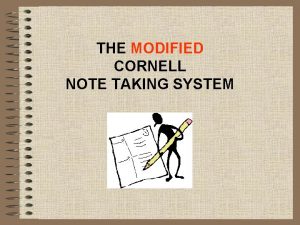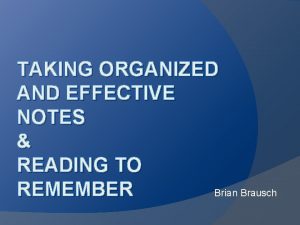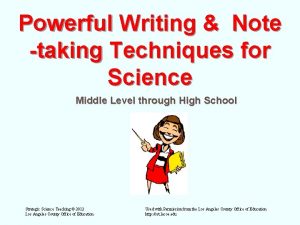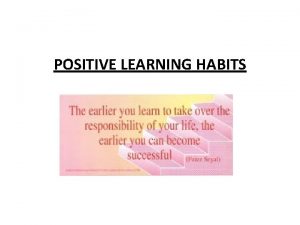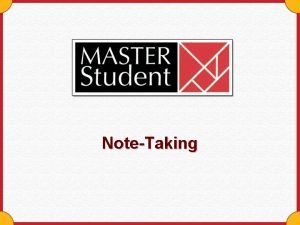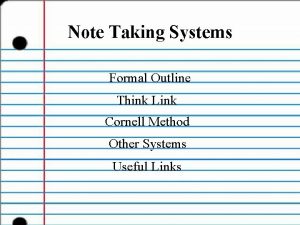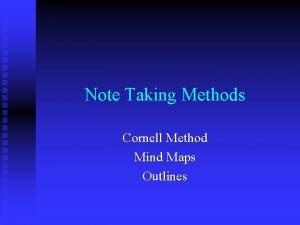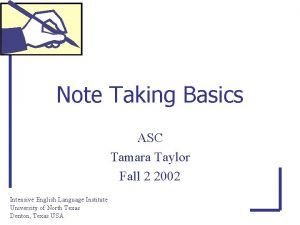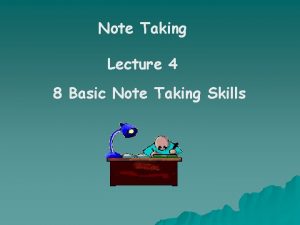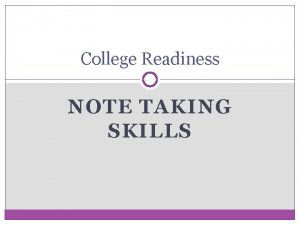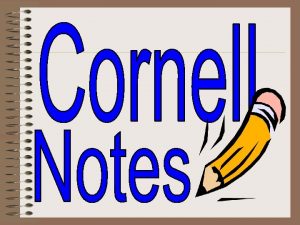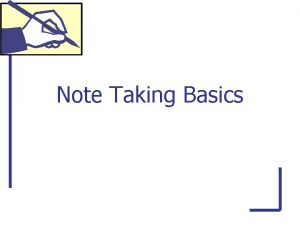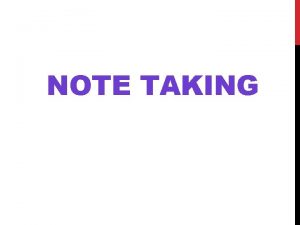NOTE TAKING Definition Note taking is the practice














- Slides: 14

NOTE TAKING

Definition: ■ Note taking is the practice of writing down pieces of information in a systematic way. DSchneider has the impression that Note taking includes the following: • Taking notes in a lecture or a discussion • Taking notes in a lecture + processing/annotating/rewriting these notes • Taking notes from reading / on the Web in some systematic way.

Purpose: ■ Taking notes is an important part of the life of every student. There are two main reasons why note-taking is important: 1. When you are reading or listening, taking notes helps you concentrate. In order to take notes - to write something sensible - you must understand the text. As listening and reading are interactive tasks, taking notes help you make sense of the text. Taking notes does not mean writing down every word you hear; you need to actively decide what is important and how is related to what you have already written. 2. Notes help you to maintain a permanent record of what you have read or listened to. This is useful when revising in the future for examinations or other reasons. ■ Good notes should be accurate, clear and concise. They should show the organization of the text, and this should show the relationship between the ideas.

Note Taking Methods: 4 methods are as following ■ The Cornell method ■ SQ 3 R ■ Concept maps and mind maps ■ Charting

The Cornell method ■ The "Cornell method" has been designed for classroom note taking and it includes postprocessing. Cornell method is probably the most useful method for students at university. It was devised 40 years ago by Walter Pauk, a lecturer at Cornell University in the United States, for his students. This method is used by dividing the paper in two columns. The first column is used to enter key or cue words while the second is the notes column (for recording ideas and facts). There are six steps to Cornell note-taking: • Record During the lecture, record as many facts and ideas as possible in the note column. • Reduce After the lecture, read through the notes taken and reduce to key words and phrases, or questions. The key words and phrases are used as cues to help recall the ideas and facts. The questions are to add clarity to the facts and ideas. • Recite Using only the key words, phrases and questions in the cue word column recite the ideas and facts in the note's column. It is important that you are not just mechanically repeating but using your own words.

• Reflect Based on the facts and ideas learnt, reflect upon how this fit in with what you already know, and how this knowledge can be applied. • Review On a frequent basis, review your past notes by reciting and reflecting upon them. • Recapitulate After you have reduced, recited and reflected upon your note, you should recapitulate each main idea using complete sentences at the bottom of the key word column.

Example:

SQ 3 R ■ Rowntree (1976: 40 -64) outlines what he calls the 'SQ 3 R' approach to reading and note taking from text. He suggests that students should use the following activities in order to get the most from a reading in the most efficient way. 1. Survey - flip through the chapter or book and note the layout, first and last chapters or paragraphs, look at the headings used, familiarise yourself with the reading. 2. Question - Ask questions about the way the reading is structured and think about the questions you will need to keep in mind while reading. Think about whether or not you think the book is relevant or if it's current and if it suits the purpose of your study. 3. Read - read actively but quickly, looking for the main points of the reading - don't take any notes - you might want to read through twice quickly.

1. Recall - Write down the main points of the reading and any really important facts, and opinions that help support the main points. Also record the bibliographic details. 2. Review - repeat the first three steps over and make sure you haven't missed anything. At this point you might like to finalise your notes and re-read your notes or write down how the material you've just covered relates to your question or task


Concept maps and mind maps ■ The idea is to map out concepts, either as they are found or received or during the Review process in the Cornell or SQ 3 R method. • Mind maps (i. e hierarchical trees) can be used to take lecture notes in real time, but more often to organize concepts into a hierarchical tree. • Concept maps allow to visualize more complex relationships between different concepts. They allow for example to integrate old and new knowledge and to construct a representation of a complex concept. Finally, concept maps also can be used a design tool. For example, after the initial literature review for a paper or a thesis, a student may create a conjecture map that relates theory to design to observable process to outcomes.


Charting ■ Charting is method that helps to summarize the most important concepts found in articles and to identify implicit relations (what concepts go together and which authors). This concept charting technique uses a table with columns representing concepts and rows representing a text. Recommended procedure – Step 1: Read texts "diagonally", and just mark the most relevant concepts, theories, models, hypothesis, etc. – Step 2: Make a matrix of the most important concepts like above – Step 3: Sort concepts. Keep the most important ones, unite the similar ones and throw away the ones you won't need (the theory part must support the empirical part, nothing else) – Step 4: Write

 Difference between note making and note taking
Difference between note making and note taking Signal words example sentences
Signal words example sentences Difference between note making and note taking
Difference between note making and note taking Relevance of note making
Relevance of note making Note taking legend
Note taking legend Outline method of note taking
Outline method of note taking Section 17-3 note taking guide answer key
Section 17-3 note taking guide answer key What are the 5 r's in note-taking?
What are the 5 r's in note-taking? What are the 5 r's of note taking
What are the 5 r's of note taking Note taking process
Note taking process Think link note taking method
Think link note taking method What are the 5 r's in note-taking?
What are the 5 r's in note-taking? Mind mapping note taking method
Mind mapping note taking method Foweu
Foweu Note taking 101
Note taking 101




